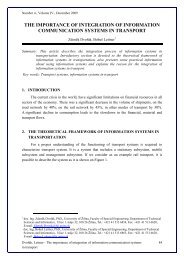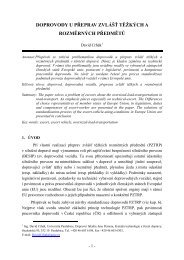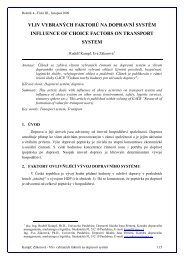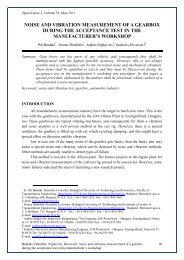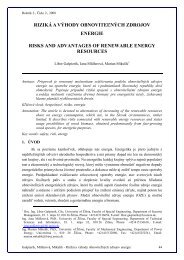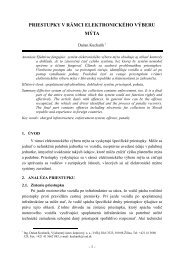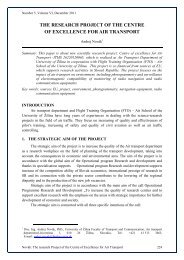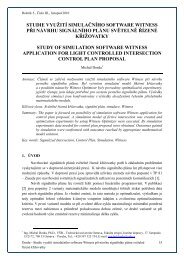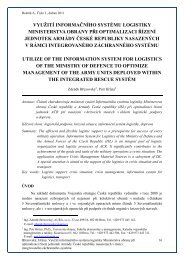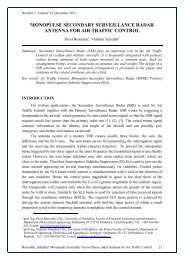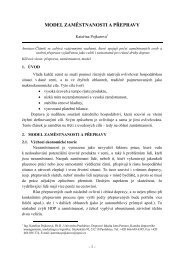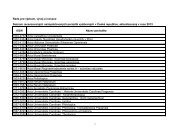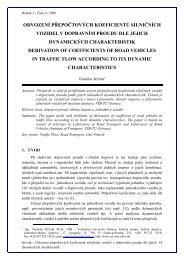ils â instrument landing system ground-based ... - Perner's Contacts
ils â instrument landing system ground-based ... - Perner's Contacts
ils â instrument landing system ground-based ... - Perner's Contacts
Create successful ePaper yourself
Turn your PDF publications into a flip-book with our unique Google optimized e-Paper software.
4.2. Glide Slope signal receiverSimilar to the localizer it receives, processes and displays the signal from the glideslopearray. Glide-slope path display is identical to the localizer indication. Above OM 4 eachdot means a deviation of about 500 ft (150m) in the vertical direction from the prescribedglide-slope path. Absolute deviation size (to a single dot) drops when approaching the runwaytouchdown zone – above MM 5 is only 150 ft (45m)/dot, see fig. 2. [4]Fig. 2 - Deviation from path above RWY 6 touchdown zoneSource: [4]5. ILS CATEGORIESILS Categories generally characterize the ILS <strong>system</strong> preciseness and define itsoptions for utilization. The significance of the categories gains in significance especiallyduring low path visibility and low cloud base, so called LVO 7 . The lowest demand onprecision, backup and level of ILS airport <strong>ground</strong> equipment as well as airplane are requiredby ILS category I. Approach in this category can be performed manually or with the use ofautopilot. Other categories (II & III) are then used for the mentioned LVO operation. With4 OM – Outer Marker, usually located generally 6500-11000 m from the runway touchdown zone.5 MM – Middle Marker, usually located generally 1000 m from the runway touchdown zone6 RWY – Runway take-off and <strong>landing</strong> strip7 LVO – Low Visibility OperationČapková – ILS–Instrument <strong>landing</strong> <strong>system</strong> <strong>ground</strong>-<strong>based</strong> <strong>instrument</strong> approach <strong>system</strong> 42
these categories it is required that the approach is to be performed with an operating autopilot,poss. autopilots (CAT III) and autoland be used in case of CAT III. Categories are commonfor ILS as well as MLS. 8 Individual categories are defined as follows:• category I:precise <strong>instrument</strong> approach for <strong>landing</strong> with a decided altitude above 200 ft (60m)and either visibility above 800 m or runway visibility above 550m,• category II:precise <strong>instrument</strong> approach for <strong>landing</strong> with a decided altitude above 100 ft (30m) to199 ft (60m) and with runway visibility at least 300 m,• category III. A:precise <strong>instrument</strong> approach for <strong>landing</strong> with a decided altitude above under 100ft(30 m) and with runway visibility at least 200 m,• category III. B:precise <strong>instrument</strong> approach for <strong>landing</strong> and <strong>landing</strong> with a decided altitude under50 ft (15 m) or without decided altitude limitation and with runway visibility above200 m.• category III. C:precise <strong>instrument</strong> approach for <strong>landing</strong> and <strong>landing</strong> without a decided altitude andpath visibility. [2]The above stated decided altitudes are related to the radio navigation device itself, notto the specific approach. Altitudes published for individual categories in maps are relevant forthe autopilot. In order to be classified into a specific category the airport must comply withspecific criteria relative to lighting and security.From experience, I state classifications for several select airports around the CzechRepublic:• Prague Ruzyně Airport LKPR – has an ILS CAT I <strong>system</strong> implemented with all 4directions, CAT II and III A are installed only on runway 24,• Airports Pardubice LKPD and Brno Tuřany LKTB – have an ILS CAT I alwayswith one direction,• Vodochody Airport LKVO – has an ILS CAT I,• Ostrava - Mošnov Airport LKMT – is currently commissioning ILS CAT II.6. CONCLUSIONIn the article I’ve focused on one element of airline navigation <strong>system</strong>, specifically theILS <strong>system</strong> for precise aircraft approach for <strong>landing</strong>. It is a well known and highly usednavigation <strong>system</strong> in air commerce around the world.8 MLS – Microwawe Landing System enables approach under various descent angles individually foreach plane. It is considered to be a possible successor to ILS. MLS is impossible in the near future due to the<strong>system</strong>’s high installation costs at airports and in airplanes.Čapková – ILS–Instrument <strong>landing</strong> <strong>system</strong> <strong>ground</strong>-<strong>based</strong> <strong>instrument</strong> approach <strong>system</strong> 43
Some airports in CZ are currently performing optimization of the ILS for the purpose ofincreasing classification. For example the Vodochody Airport LKVO is working onimproving lighting and security conditions to increase conditions from CAT I to CAT II.ILS is a great example that a simple and reliable idea can survive practically all othernavigation <strong>system</strong>s and at the same it is in the long run able to be competitive with innovativesolutions within the aircraft navigation issue.7. LIST OF ABBREVIATIONSDME - Distance Measuring EquipmentILS - Instrument Landing SystemLLZ – LocalizerOM - Outer Marker located about 6500-11000m from the runway touchdown zoneRWY - Runway – take off and <strong>landing</strong> strip8. REFERENCES[1] SOLDÁN.V. Letové postupy a provoz letadel (Flight procedures and air traffic).Letecká informační služba Řízení letového provozu ČR (Flight Information Service forAir Traffic Control Over CZ):1 st edition 2007 ISBN 976-80-2398595-5[2] Škola pilotu (Pilot´s School) [online].c2009 [cit. 2009-11-21]. Available athttp://new.csav.cz/vyukove-centrum/skola-pilotu[3] ILS - <strong>instrument</strong> <strong>landing</strong> <strong>system</strong> [online]. C2008-9 [CIT. 2009-09-12]. available athttp://fs1.vsb.cz/3_smutny/cviceni/2008-09/rizeni%20<strong>system</strong>u%20letadel/adamec_sp_24.doc[4] ILS - Instrument Landing System [online]. c2006 [cit. 2009-11-27]. Available athttp://www.vacc-cz.org/download/uploads/ILS_15_03_06.pdfReviewers:prof. Ing. Zdeněk Žihla, Ph.D.Business University of Prague, Department of Air TransportIng. Hana CísařováUniversity of Pardubice, Jan Perner Transport Faculty, Departmentof Transport Technology and ControlČapková – ILS–Instrument <strong>landing</strong> <strong>system</strong> <strong>ground</strong>-<strong>based</strong> <strong>instrument</strong> approach <strong>system</strong> 44




